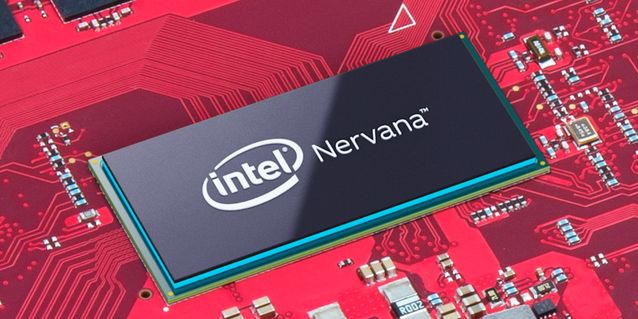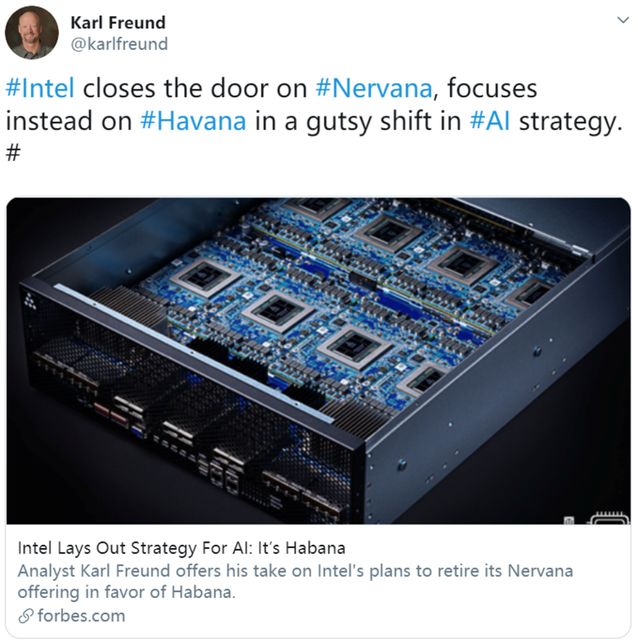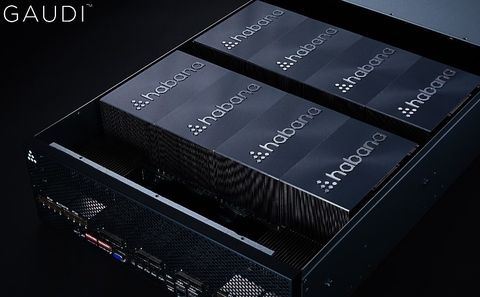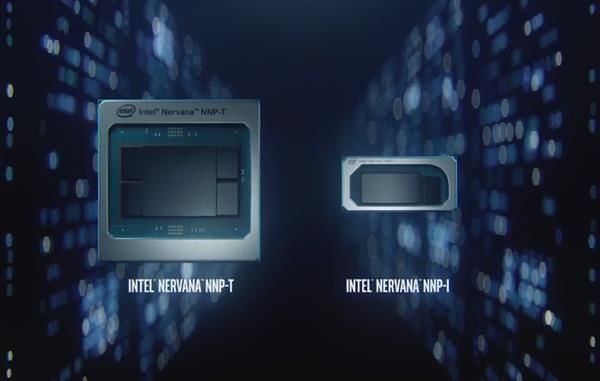Alternatively, Habana defeated Nervana for its outstanding scalability technology and design, as well as its ability to deliver in volume.
Editor’s note: This article comes from WeChat public account “The power of machines” ( ID: almosthuman2017), the author is slightly fat.

After acquiring two cloud AI chip startups in succession to consolidate its most important data center market, Intel finally made a choice between the two tigers.
Habana beat Nervana for its excellent scalability technology and design, and its ability to deliver in volume. But this does not mean victory in the end. For Intel, as long as he sees the opportunity to surpass Nvidia, he will not hesitate, the key is only to choose the right chip. Habana beat Nervana for its excellent scalability technology and design, and its ability to deliver in volume. But this does not mean victory in the end. For Intel, as long as he sees the opportunity to surpass Nvidia, he will not hesitate, the key is only to choose the right chip.
Recently, foreign media have disclosed Intel’s new actions in the field of AI. Forbes said that Intel will stop TSMC ’s 16nm foundry Nervana chips, mainly the Nervana NNP-T series. Intel did not announce the matter with much fanfare, but has informed analysts and customers via email:
The development of the Nervana NNP-T training chip (formerly codenamed Spring Crest) has been discontinued, but the promise made to customers by the inferential chip Nervana NNP-I (codenamed Spring Hill) will be honored.
The Habana product line offers a powerful strategic advantage of a unified, highly programmable architecture that is simultaneously oriented to inference and training. By moving to a single hardware architecture and software stack to enable data center AI acceleration, our engineering team can work together to deliver more innovation to our customers more quickly.
This Friday, deep learning analyst Karl Freund also tweeted that Intel will completely stop the NN of deep learning chip startup Nervana that Intel acquired in 2016.P-T products, while focusing on Habana Labs.

1. Why buy two cloud AI companies?
Although Intel’s AI terminal, edge computing and cloud have layouts, the most important thing is to take advantage of Intel’s strong position in cloud data centers to ensure its position in the cloud AI chip market. This is also the important reason why it successively acquired two cloud AI chip companies, Nervana and Habana.
On December 16, 2019, rumors of Intel’s acquisition of Habana Labs were finalized. This acquisition continues Intel’s “big-footed” style-$ 2 billion, second only to Mobileye’s second largest acquisition.
At the time, Habana had two products, Gaudi AI Training Processor and Goya AI Inference Processor. It is worth noting that the Gaudi artificial intelligence training processor is already providing samples for specific hyperscale customers, and the Goya artificial intelligence inference processor is commercially available.
Among them, Gaudi is the micro-architecture used by Habana to accelerate training. Designed using the TSMC 16-nanometer process, the chip integrates eight TCP and GEMM engines in a cluster. Goya is Habana’s microarchitecture for accelerating inference. Goya is manufactured on TSMC’s 16-nanometer process, which is actually a simplified version of Gaudi.

But, before the acquisition of Habana, 2016 In August, Intel acquired deep learning technology startup Nervana for $ 408 million.
The main product of this company is Nervana neural network chip. Its architecture design is very special, and it needs high performance for AI.The feature of memory capacity has abandoned the standard cache system and used software to manage the memory system.
However, unlike Habana, Nervana does not have mass production products. Three years after the acquisition of Nervana, Intel launched Nervana NNP-T and Nervana NNP-I.

Nervana NNP-T series, codenamed Spring Crest, is mainly for AI training. It uses TSMC 16nm process production, core area up to 680mm2, integrated 27 billion transistors, 32GB HBM2 memory, frequency 1.1GHz, TDP 150-250W, Benchmark NVIDIA Tesla series GPU acceleration chip.
In contrast, the Nervana NNP-I series AI chip is much smaller, codenamed Spring Hill, which is mainly oriented to AI inference applications. The CPU part is Intel ’s 10nm process Ice Lake core, and the power consumption is between 10-50W. There are two specifications of M.2 and PCIe, which are more compact and flexible.
2. Who is more reliable?
A month before the announcement of Habana, Intel reiterated its delivery plans for Nervana chips. At that time, some analysts believed that the acquisition may indicate that customers were not satisfied with Nervana hardware and were unwilling to use Nervana again. Since Nervana cannot keep up with the rapidly growing market, Intel will continue to explore other options.
Today, Intel has discontinued TSMC’s 16nm foundry Nervana chip, which also confirms this speculation. Intel said it made the decision after seeking feedback from its engineers and major customers. Feedback indicates that the second-generation Nervana designs, codenamed Spring Hill and Spring Crest, simply do not meet the requirements of those high-performance workloads.
These customers also mentioned that Habana is a preferred platform to compete with Intel. Among them, Facebook has made it clear to Intel: “You need a better coresheet. “
First, Habana network technology is likely to be one of the key reasons for Intel’s decision to abandon Nervana in favor of Habana technology.
Nervana’s Neural Network Processor (NNP-T) scales with a proprietary interconnect, while Habana’s Gaudi can scale to thousands of nodes via standard 100Gb Ethernet. Moreover, Gaudi even supports remote direct memory access RDMA, a feature that enables software to access memory in the entire fabric without increasing the burden on the remote CPU.
This structure can significantly improve the performance of training large-scale neural network models to cope with the trend of doubling the size of neural network models every 3 and a half months, handling the trend of increasingly complex AI tasks.
In addition, some analysts pointed out that full consideration of software and hardware coordination when designing the underlying compiler and software architecture also helped Habana chips achieve better scalability. . According to official figures, its overall distributed performance can be close to linear even when the number of processors is greater than 600. Compared to Nvidia V100 GPU, the training performance is improved by nearly 4 times, which is a very remarkable result. .
Finally, Habana chips are not only more powerful, they have been shipping since the end of 2018. In contrast, Nervana not only took three years from acquisition to product delivery, but also the product was repeatedly delayed.
Buying out a competitor is a logical move by Intel. Habana’s “superior” success does not mean that he will not be replaced one day. After all, Groq is doing its best, and more companies are bringing their chips to market.
For Intel, as long as he sees the opportunity to surpass Nvidia, he will not hesitate. The key is whether he has selected the correct chip.


A month before the announcement of Habana, Intel reiterated its delivery plans for Nervana chips. At that time, some analysts believed that the acquisition may indicate that customers were not satisfied with Nervana hardware and were unwilling to use Nervana again. Since Nervana cannot keep up with the rapidly growing market, Intel will continue to explore other options.
Today, Intel has discontinued TSMC’s 16nm foundry Nervana chip, which also confirms this speculation. Intel said it made the decision after seeking feedback from its engineers and major customers. Feedback indicates that the second-generation Nervana designs, codenamed Spring Hill and Spring Crest, simply do not meet the requirements of those high-performance workloads.
These customers also mentioned that Habana is a preferred platform to compete with Intel. Among them, Facebook has made it clear to Intel: “You need a better coresheet. “
First, Habana network technology is likely to be one of the key reasons for Intel’s decision to abandon Nervana in favor of Habana technology.
Nervana’s Neural Network Processor (NNP-T) scales with a proprietary interconnect, while Habana’s Gaudi can scale to thousands of nodes via standard 100Gb Ethernet. Moreover, Gaudi even supports remote direct memory access RDMA, a feature that enables software to access memory in the entire fabric without increasing the burden on the remote CPU.
This structure can significantly improve the performance of training large-scale neural network models to cope with the trend of doubling the size of neural network models every 3 and a half months, handling the trend of increasingly complex AI tasks.
In addition, some analysts pointed out that full consideration of software and hardware coordination when designing the underlying compiler and software architecture also helped Habana chips achieve better scalability. . According to official figures, its overall distributed performance can be close to linear even when the number of processors is greater than 600. Compared to Nvidia V100 GPU, the training performance is improved by nearly 4 times, which is a very remarkable result. .
Finally, Habana chips are not only more powerful, they have been shipping since the end of 2018. In contrast, Nervana not only took three years from acquisition to product delivery, but also the product was repeatedly delayed.
Buying out a competitor is a logical move by Intel. Habana’s “superior” success does not mean that he will not be replaced one day. After all, Groq is doing its best, and more companies are bringing their chips to market.
For Intel, as long as he sees the opportunity to surpass Nvidia, he will not hesitate. The key is whether he has selected the correct chip.